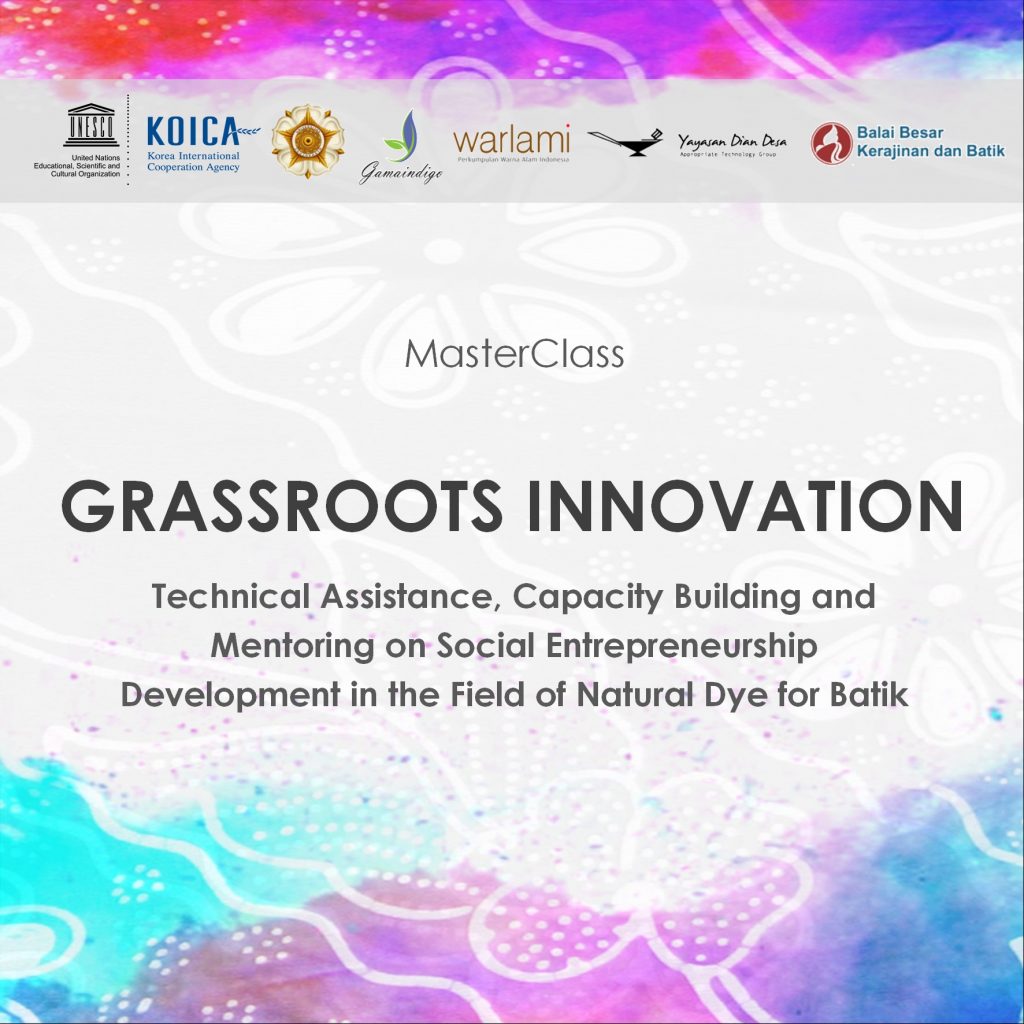
Batik is one of Indonesian Intangible Cultural Heritage[i] of Humanity inscribed in 2009. The processes and techniques of dying the fabric have been national pride for Indonesia as everyday batik designs are worn regularly, while special varieties are incorporated into special occasions or even certain cultural rituals.
Moreover, fashion industry contributing significantly to greenhouse gas emissions, energy consumption and waste (water and solid) production[ii], stakeholders in the fashion industry are essential and unavoidable partners in achieving the Sustainable Development Goals (SDG). As a more environmental friendly alternative and taking advantage of public growing concern about how clothes they wear are made, efforts in promoting both re-introduction and local and indigenous technics especially in natural dyes are encouraged in Batik industry. However naturally died batik products are still facing quality challenges making them difficult to develop in the growing natural product international market.
Hence, UNESCO, with the support of the Korean International Cooperation Agency (KOICA) and in partnership with Gamaindigo UGM, Balai Besar Kerajinan dan Batik (BBKB), Warlami dan Yayasan Dian Desa, with the technical support of Prof Heo Bugku from Naju-san Natural Dye city and in consultation with UNESCO Category 2 Centre, International Information and Networking Centre for Intangible Cultural Heritage in the Asia- Pacific Region (ICHCAP) Daejeon, Republic of Korea, discussed and trained 30 female batik artisans during a 3 days workshop entitled “GRASSROOTS INNOVATION: Technical Assistance, Capacity Building and Mentoring on Social Entrepreneurship Development in the Field of Natural Dye for Batik” on 19 – 21 June 2019 in Yogyakarta, Indonesia.
The workshop materials (lectures’ video with subtitles in Bahasa Indonesia and hands-on activities) are available for free online after registering at at UNESCO e-learning platform: http://bit.ly/batikalami
Join us and improve your knowledge about natural dyed batik, colour fastness, and get an introduction on how you can improve market penetration by using social media and online market place, and how to brand your products effectively by defining the identity of your product and the story you want to tell.
This project will be contributing to SDG 9 and SDG 17.
List of Topics
- World Trend on Natural Dyeing and Improving Quality of Indigo Dyeing (Penggunaan Pewarna Indigo di Dunia dan Peningkatan Kualitas Pewarnaan Indigo) – Prof Heo Bukgu, Naju Natural Dye City Foundation
- Persimmon Dyeing and Fixator for Improving Colour Fastness (Penggunaan Kesemek sebagai Pewarna dan Fiksasi Warna) – Prof Heo Bukgu, Naju Natural Dye City Foundation
- Batik and Development of Natural Dye in Indonesia (Batik dan Perkembangan Pewarnaan Alami di Indonesia) – Lecturer: Ms. Irfai’na Salma, S.ST., M.Sn., Centre for Handicraft and Batik, Ministry of Industry and Trade Balai Besar Kerajinan dan Batik (BBKB, KEMENPERIN)
- Development of Natural Dye in Indonesia: Perspective of Gamaindigo (Pengembangan Pewarna Alami Nusantara) – Lecturer: Dr. Ir. Edia Rahayuningsih, M.S, Research Center of Natural Dye, Gadjah Mada University (Pusat Kajian Zat Warna Alami, Unversitas Gadjah Mada)
- Introduction to Eco-Printing Method and Method of Natural Dyeing in Red Color (Mengenal Metode Eco-Printing dan Teori dan Metode Pencelupan Warna Merah) –Lecturer: Prof. Heo Bukgu, Naju City Foundation of Natural Dyeing Cultural Institute, Naju, South Korea
- Product Development of Natural Dyed Batik (Pengembangan Product Batik Natural Dye) – Lecturer: Ms. Melvin Margareta, PT Out of Asia
- Market Access for Natural Dyed Batik (Akses Pasar Batik Natural Dye) – Lecturer: Ms. Melvin Margareta, PT Out of Asia
- Practical Theory of Textile and Batik Dyeing using Natural Dye Produced by GamaIndigo (Teori Praktis Pewarnaan Tekstil dan Batik dengan Pewarna Alami GamaIndigo) – Lecturer: Dr. Ir. Edia Rahayuningsih, M.S, Research Center of Natural Dye, Gadjah Mada University (Pusat Kajian Zat Warna Alami, Unversitas Gadjah Mada)
- Dyeing Process with Persimmon (Proses Pewarnaan Dengan Kesemek) – Lecturere: Prof Bukgu Heo, Naju City Foundation of Natural Dyeing Cultural Institute, Naju, South Korea
